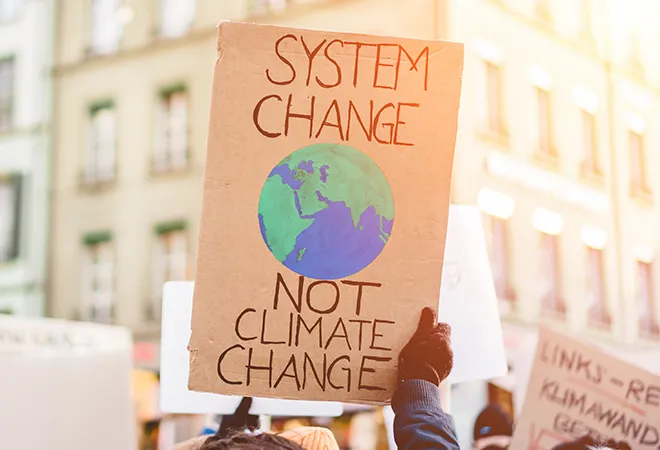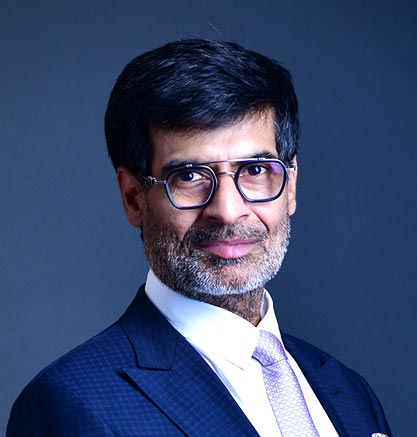-
CENTRES
Progammes & Centres
Location

It is a truth that all accept but few wish to acknowledge: there is a direct relationship between overall well-being and carbon emissions. The growth trajectories of advanced economies have been achieved by exploiting the world’s carbon budgets. The developed world’s depletion of global atmospheric commons has led to extreme climatic events across the planet. Climate change is already upon us due to industrialisation in Europe and North America in the past, and in China more recently. Countries that have contributed the least towards historical global emissions — countries that are still developing and poor — are left to fend for themselves. Global poverty has underwritten the riches of the developed world. Climate finance contributions from the Global North have been insignificant and incommensurate with the transition costs for emerging economies. Developing countries will require at least $1 trillion in energy infrastructure alone by 2030, and up to $6 trillion across all sectors annually by 2050 to mitigate climate change. In addition, annual climate adaptation costs in these economies could reach $300 billion by 2030 and as much as $500 billion by 2050. Further, developing countries are likely to face $290-580 billion in annual “residual damages” by 2030 and over $1 trillion in damages by 2050 from the impact of climate change that cannot be prevented by adaptation measures. There is hardly any acknowledgement, let alone support, for this crisis. The debate on Loss and Damage (L&D) is mired in ambiguity. It was only in 2013, at COP19, that Loss and Damage became officially recognised. It was later included as the distinct Article 8 of the Paris Agreement at COP21, with no reference, however, to finance or equity. The segregation of L&D and adaptation was viewed as a geopolitical gambit to separate the Alliance of Small Island States (AOSIS) from other emerging economies. This deprived large developing countries of climate finance and technology by conflating them with developed nations. Since global climate funds are constrained, it has been argued that opening a window for L&D would impact finance for adaptation and mitigation, and reduce the ability of larger emerging economies like India to tackle climate change.Too little attention is paid to the developing countries’ need for “adaptation” to the effects of the carbon that is already in the atmosphere.
The conclusion is unavoidable: L&D financing must emerge as an independent stream in climate negotiations. Instituting special arrangements for strengthening L&D finance, independent from mitigation and adaptation, is particularly vital. India’s climate action will be constrained by its development imperatives. Despite ambitious Nationally Determined Contributions (NDCs) commitments, the realisation of India’s climate goals is strongly linked to the availability and quality of capital at its disposal. India needs about $2.5 trillion till 2030 for NDCs. Currently, the tracked green finance in India represents approximately 25% of the total required across sectors for mitigation alone. Adaptation flows are even more pitiful. Given India is among the most vulnerable to climate change, adaptation clearly needs more resources. But these demands are unlikely to be met by global adaptation funds, which are limited and expected to prioritise small and fragile island states. Therefore, it stands to reason that India privileges adaptation to support its communities and people from its own domestic budgets. Mitigation actions must, then, be backed by international finance flows. India — and indeed no developing country — can do both. It cannot be expected to pay for its future as well as pay for Europe and America’s past. COP27 is an opportunity to voice the Global South’s collective demands and reconcile various channels of climate financing. The international community must respond. Else the developing world will find itself preaching to the parish of the prejudiced.The segregation of L&D and adaptation was viewed as a geopolitical gambit to separate the Alliance of Small Island States (AOSIS) from other emerging economies.
The views expressed above belong to the author(s). ORF research and analyses now available on Telegram! Click here to access our curated content — blogs, longforms and interviews.

Samir Saran is the President of the Observer Research Foundation (ORF), India’s premier think tank, headquartered in New Delhi with affiliates in North America and ...
Read More +